

| Peter Upton's |
|
Subbuteo Tribute Website. |
|
Focus On.... |
|
The Story of Black Players in Subbuteo. |
As is appropriate for a game that has always strived for realism, the history of black players in Subbuteo closely mirrors their treatment in British football as a whole - initially ignored, often completely misunderstood, but then slowly accepted (with some embarrassing hiccups along the way....).
My own interest in the subject probably started a few years ago, when I was sorting out my surplus lightweight spares for a (Maidenhead) swap meet. I knew that there were two versions of ref 701 Crystal Palace (the central stripe can be blue or red), so I was carefully checking the two versions I owned to see if they were different. Whilst the kits were the same, one team had black players, and the other did not. I knew that Waddingtons had introduced black players into their Premiership teams in the mid-1990s, but this team did not exist as a Premiership side. So which teams had black players? And when?
I discovered that the Premiership black players arrived the season before the Premiership boxes in 1994-95. They are an important milestone in the Subbuteo story, and this page is set up to celebrate them, and to give a collectors guide to those who want to put this subset of teams together. However, black players in Subbuteo (thankfully) do not begin in the 1990s, and I thought it would be fun to look at their history as a whole.
(I thought this would be a little article. It didn't really turn out that way).
June 2020: I did an internet search on this after I'd written the page, and found an article in the Daily Mirror from 2016 which credits footballer Ashley Williams (then aged nine) and his mum, for the production of black players in Subbuteo. (they wrote a letter asking why there were no black players in his England team). Subbuteo sent him some freebies, and the teams were changed. Well done Ashley!! Hopefully his wasn't the only letter they received.
In the Beginning.....


As most website visitors are aware, Subbuteo began in 1947, and existed in a flat card/celluloid form throughout the 1950s. At this time in Britain, there were very few black players. The history books always seem to use the same examples:- Lloyd Delapenha at Portsmouth and Middlesbrough (1948-57), and Charlie Williams at Doncaster Rovers (1948-58). Even into the 1960s things do not change radically - although South African Albert Johanneson (Leeds Utd 1961-70) became the first black player to play in an FA Cup final. So nobody considered it odd that Subbuteo players were all white. Quite literally in fact, as they did not use any flesh colour on the players of the period. The white of the card or celluloid was considered sufficient.
It's all about Pele....
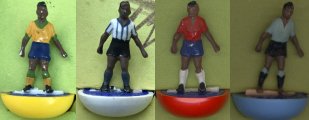
The 1960s were all about Pele. Arguably the first globally renowned black footballer, and an all round superstar. His fame was reflected in Subbuteo when they looked to launch their 1966 World Cup team range. Until then, all Subbuteo new OO scale players had been painted in a pale flesh, and Brazil had been represented in Subbuteo catalogues (rather inaccurately) by reference 26.
In an age of limited information and black and white photography, Subbuteo treated Pele, and his famous team mates such as Garrincha, Didi and Jairzinho, not only as the norm for Brazil, but for the whole of South American football. For the releases of Brazil, Argentina, Uruguay and Chile, Subbuteo's painters were instructed to use the brown paint usually reserved for hair and boots to produce the first black teams. How exotic they looked to British children in the 1960s.... if not very accurate. It has been pointed out, for instance, that Chile had no black players at this time.....
I must admit to at least a couple of e-mails from website visitors asking me to identify "this African team I have acquired". "This African team" was actually Argentina. I suppose the dark blue striped shirt doesn't help with identification, but still....
At least it was a start.
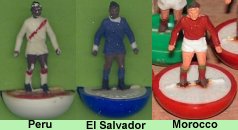
By the 1970 World Cup the teams had switched to the classic heavyweight figure, and the black teams were joined by Peru and El Salvador. Peru, like Brazil, had a high profile black superstar striker - Teofilio Cubillas. Interestingly, they were not joined by Morocco. To be blunt, Subbuteo only had the two skin-tone paints, and somebody was having to decide which countries and teams were deemed dark enough to be painted black. A 1970 World Cup promotional item recently surfaced that has a black Morocco player, but I now have doubts to whether this was genuine.
A black Santos (Pele's club side) arrived in 1973, and the 1974 World Cup saw Zaire and Haiti added to the ranks.
Meanwhile at the cricket.....
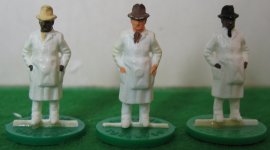
The best thing in Subbuteo cricket was certainly the West Indies team, as all the sides were restricted to white outfits, and the skin colour made them look unique. Subbuteo also painted West Indian umpires, which I've always loved.
The Legend of Clyde Best.
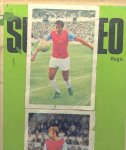


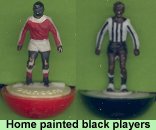
Clyde Best was a talented Bermuda-born centre forward, who made his debut for West Ham United in 1969. As television coverage of British football became more widespread in the early 1970s, so Best became a trailblazer for black players in the game. (shown above is a Subbuteo box of the era adorned with a Clyde Best sticker).
His Subbuteo legend, seems more like an Urban Myth these days. When the Subbuteo collecting pioneers started pooling their knowledge in the late 1990s it seemed that everyone had acquired, or at least seen, an early 1970s West Ham United team with a single player painted with black skin. Was this done by Subbuteo employees? Did the housewives of Kent paint Clyde Best? As time has gone on, and hundreds of teams have passed through ebay, the answer to this question seems, sadly, to be no. The Clyde Best question has faded away, and I must admit to never seeing a convincing one.
And yet, that answer does have a plus side. What it means is that kids up and down the country did their bit for racial diversity, in their bedrooms with a paintbrush. They looked at these supposedly realistic teams and saw what was missing. Clyde Best isn't the only player to be honoured in this way. I have a late 1970s Nottingham Forest team, where the previous owner has painted in Viv Anderson (the first black player to represent England no less). I have black players painted onto lightweight Newcastle United, and Liverpool teams. Shown above, a "Clyde Best" painted onto a early 1970s West Ham away kit, my "Viv Anderson", and a player added to a later Newcastle United.
Do other collectors own any hand-painted black players of the vintage? Garth Crooks at Stoke City perhaps? Or Vince Hilaire at Crystal Palace? Send in a photo to the website, and we'll add them to this hall of fame.
January 2024: Clyde Best in his home kit has turned up. Owner Roy Boulter is fairly sure his shop bought side featured this chap. Trouble is, he is on a standard pink flesh plastic, so there is not another paint colour that the skin tone has been painted over, and that means the play-wear doesn't really tell us anything one way or the other. Still, here he is. Anybody else holding one of these?
The French lead the way....
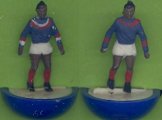
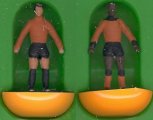

Whilst the British mixed teams were (probably) only the product of bedroom painters, the French teams of the late 1970s famously did add two black players to both their national team and club sides. It was not universal, but it was reasonably common. As many of these teams were painted and sold in the UK, one does wonder why the same did not apply to appropriate British teams, and especially the England national side. Mind you, a look at the Panini World Cup sticker album from 1982 (even though later in date) shows that the French were still the only European side with black players featured as stickers (Marius Tresor, Jean-Amadou Tigana and Jacques Zimako fact fans). We had a long way to travel.....
The team most likely to be encountered with this variation is the French national team on reference 164, in either heavyweight or zombie. I first acquired this heavyweight in a batch of second-hand teams when I was about fifteen years old, in the mid-1980s. It came in the late-1970s small box with plastic insert. I remember wondering if they were real - especially as some of the trim was missing (the white trim was forgotten - see above). However, the skin was clearly not over-painted. I suspect that one painter had been instructed to paint the white players, and another had done the black ones, before they were combined at assembly stage. Another team with black players that I own is a zombie reference 306 Paris FC. However, the two black players provided are in the wrong kit (they are ref 249 instead). Not great, and these two errors are perhaps a reason why Subbuteo did not roll out their introduction. Things could go wrong. It was a nuisance. (Also shown above - a mixed h/w Bastia. The version of this I own does not have the black players though).
Elsewhere, the all-black teams continued to grow - with Subbuteo making some odd choices along the way. Some perhaps made sense individually, but not when compared to other teams in the range. Mexico were white, but El Salvador were black. Iran were white, but Kuwait were black. Morocco were white, but Algeria were black.
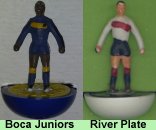
Perhaps the most striking contrasts involve the South American club sides. A large batch of these were introduced, initially in Italy, in 1976. They decided at that time that all these teams should have black players. However, River Plate (who had arrived much earlier) was a pale-skinned team, and if you set out to play this important South American derby, the contrast was stark....
The arrival of Machine Printed Players.
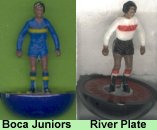
The 1980s was an era of automation for Subbuteo, as they introduced machines for painting and assembling the new lightweight figures. The teams lost the individual painting styles of the previous era, and with it even the French teams sadly lost their multiracial mix. Even the hand-painted teams of this era tend to be painted on players where the (light) flesh colour had already been machine-printed to the player (to speed things up).
Machine printed all-black teams were produced of course, and in increasing numbers as more non-European qualifiers were added to the World Cup including classics such as 403 Cameroon (in 1982), and 716 Egypt (in 1990). The machine-printed dark skin tone was of a less dramatic shade, and some of the quirks in the range were ironed out. Note the darker River Plate machine-print above - although it was a shame they didn't correct the kit at the same time. It's supposed to be a sash! Even Mexico had dark skinned players when reference 803 was released for the 1994 World Cup.
However, the number of black players in the domestic game in the UK was continuing to grow, and the question started to be asked more and more. Where was the representation in Subbuteo? Was this really that difficult to achieve? Waddingtons had to act, and they did - eventually....
The Premier League Era.
The mixed teams were introduced with a promotional campaign in 1994-95. I can remember it, along with the general (and very British) responses of "what took you so long" and "I assumed that would already have happened". Even then, it was only for the English Premiership range. Subbuteo sales and tournaments were in sharp decline by this time, so it wasn't great timing....
Still better late than never right? So here is the list of Premiership teams who were lucky enough to gain an improved racial mix (three black players initially). As mentioned in my introduction, note that this is the year before the Premiership boxes were introduced, and that all teams in the Premier League boxes have black players included as standard.
1994-95 was the final year that the Premier League had 22 clubs (it reduced to 20 the next year - four teams were relegated, two promoted). Subbuteo produced thirty teams, including seven away kits, and the Manchester United 3rd. In addition, the England national side, and its away kit gained black players, and so pleasingly did Melchester Rovers*
April 2020: I don't have full access to my lightweights at present, so not all the teams are shown with a proper black player, as I'd intended. The remainder should turn up at some point.
I've added to the tables whether the team existed before the 1994-95 season (i.e. it also exists without black players), and whether it continued into the Premiership range (i.e. if you have the team in the later box, you have the black players). I hope that is helpful to collectors. For instance, the 742 Liverpool away that I received for Christmas at the time was new for 1993-94, so it did not have black players. So I've picked up a second version from 1994-95 where these players exist (perfect for Phil Babb, John Barnes and Mark Walters).

| Team Name | Ref No | Pre-1994-95 version? | Premier League Box? | Notes |
| Arsenal | 774 | No, first year of this kit | Yes | |
| Arsenal 2nd | 743 | No | No | Only issued for a single year |
| Aston Villa | 776 | Yes, 2nd year | No - new kit. | Striped version |
| Blackburn Rovers | 783 | Yes | Yes | |
| Blackburn Rovers 2nd | No | No | Only appearance - stripes. | |
| Chelsea | 802 | Yes, 2nd year | No - new kit. | |
| Coventry City | 782 | No | Yes | |
| Crystal Palace | 701 | Yes | No - Relegated. | Blue centre stripe |
| Everton | 745 | White socks. | ||
| Ipswich Town | 781 | No | No - Relegated. | Only year for this plain kit. |

| Team Name | Ref No | Pre-1994-95 version? | Premier League Box? | Notes |
| Leeds United | 778 | Yes, 2nd year. | No - new kit. | Hoops on the shirt. |
| Leicester City | 813 | No | No - relegated. | |
| Liverpool | 741 | Yes, 2nd year | No - new kit | Big Adidas stripes. |
| Liverpool 2nd | 742 | Yes, 2nd year | No - new kit | Green and black kit |
| Manchester City | 744 | Yes, 2nd year | No - new kit | |
| Manchester United | 770 | No | Yes | Short sleeve version |
| Manchester United 2nd | 771 | Yes | No - New version | All Black kit |
| Manchester United 3rd | 792 | No | Yes | First year for the blue and white |
| Newcastle United | 727 | Yes, 2nd year | No - new version | Blue sock trim |
| Newcastle United 2nd | 815 | No | No - new version. | Green and blue version |

| Team Name | Ref No | Pre-1994-95 version? | Premier League Box? | Notes |
| Norwich City | 772 | Yes | No - Relegated** | The plain version |
| Nottingham Forest | 777 | No | Yes | Black trim version. |
| Queens Park Rangers | 666 | Yes - long established. | No - a new version | The standard striped kit |
| Sheffield Wednesday | 746 | Yes, 2nd year | ||
| Southampton | 751 | Yes, 2nd year | No - a new version. | The Pony "tick" kit. |
| Tottenham Hotspur | 740 | Yes, 2nd year | No - a new version. | |
| Tottenham Hotspur 2nd | 753 | No | No - a new version. | Only appearance for purple mix |
| West Ham United | 752 | Yes, 2nd year | No - a new version | The Pony "tick" kit. |
| West Ham United 2nd | 816 | No | No | Only year for this kit. |
| Wimbledon | 749 | Yes, 2nd year | Yes | The simple navy kit. |
** I own a Hasbro boxed version of reference 772 and sadly it has no black players. I must admit to collecting extra black players from this Norwich kit to make up a lovely South Africa for my World Cup games (the all white Hasbro can be Lithuania).

*Melchester Rovers were the team that comic book character "Roy of the Rovers" played for. It was pleasing that they received black players because the comic was always quite ground breaking in this regard. West Indian winger Vernon Eliot arrived in the strip in September 1969 and played throughout the 1970s. By the time of the 1994 Subbuteo team, the comic was following the son of the original Roy, and major storylines included his friendship with black team mate Paul Ntende, who ended up playing for Nigeria in the 1994 World Cup.
Some disappointments in the Parodi Era (2002-06)
The arrival of mixed-race teams in the mid 1990s should have been the end of the story really. Sadly, evidence shows that vigilance is still required. The arrival of the Parodi range in 2006 was a bit chaotic, with the new bases only being available in a white colour. At least the teams were not all-white. These teams were being hand-painted in China, and they were initially only for the Italian market (and their Hasbro teams never received black players remember, only the Premier League). So the mix was pleasing. You can see them on my Parodi pages, where World Table Soccer picked a fair percentage of black players for its team pictures. Disappointingly, the teams do only feature two black players - so less than Waddingtons had managed.
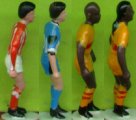
There was an amusing additional quirk to this production. The figure used in the first box sets was a bit weak at the ankles, and had to be changed for the team releases. The original box set teams had bald players and those with pony tails, but the new versions of these players were not ready for the first team releases. The first teams they reappeared in were the Scottish League teams produced for the aforementioned World Table Soccer. In these teams all the bald and pony-tailed players were painted as black players (still only the two players though - one bald and one pony-tailed).

I must mention one howler. World Table Soccer wanted a Jamaica team for the World Cup range. Somewhere along the line, from Canada to China via Italy something was lost in translation - and Jamaica turned up with the standard mix of nine white players, and only two black. The same nearly happened to a Cameroon 2nd, planned by online retailer That's Magnificent. His sample figure was painted white.... but the team did surface years later with the right skin colour thankfully.
And some more in the NetCam era (2012-20)


Honestly, this one is impossible to defend. We've reached 2012, and the start of the modern range, and you really hope these things will stop happening. Netcam showered great love on the licensed teams, making amusing likenesses of real players of all races and creeds. Hurrah. Pick of the bunch, Mario Balotelli in the Manchester City team complete with Mohican hair style.
However the standard generic teams, despite having players with different lengths of hair, failed to be racially diverse in their first editions (and this included the England national side). It was corrected quite quickly, but honestly you are lining your company up for criticism if you get this basic stuff wrong in this era.
We've had news in 2020 that the Subbuteo license has moved to a company in Hong Kong. Keep your fingers crossed that the new teams don't fall into the old trap.... again.....
That's it. You've reached the end of this potted history. Time to pick another topic.
[ Main Page ]